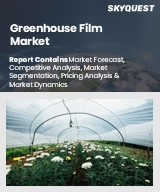
세계의 온실용 필름 시장 규모는 2023년에 69억 달러로 평가되며, 2024년 76억 7,000만 달러에서 2032년에는 177억 9,000만 달러로 성장하며, 예측 기간(2025-2032년)의 CAGR은 11.1%로 성장할 전망입니다.
세계 온실용 필름 시장은 높은 수율과 연중 농업 생산에 대한 수요 증가로 인해 강력한 성장세를 보이고 있습니다. 주요 촉진요인으로는 기후 불확실성에 대한 대응, 인구 증가에 따른 식량 공급, 생산 효율성 향상을 위한 보호 재배의 채택 증가를 들 수 있습니다. 필름 소재의 기술 혁신으로 광분산성과 단열성이 개선된 보다 효과적인 솔루션이 등장하여 농가가 기존의 유리나 열악한 플라스틱 소재에서 벗어나고 있습니다. 이러한 변화는 다양한 지역에서 정부 보조금에 의해 촉진되는 현대 농업 관행과 일치합니다. 그러나 시장은 특히 고분자 원료 가격의 변동과 플라스틱 폐기물에 대한 환경 문제 증가라는 문제에 직면해 있으며, 높은 비용에도 불구하고 지속가능한 대체품에 대한 수요가 증가하고 있습니다. 전반적으로 이러한 역학은 시장의 좋은 전망을 보장합니다.
Global Greenhouse Film Market size was valued at USD 6.9 billion in 2023 and is poised to grow from USD 7.67 billion in 2024 to USD 17.79 billion by 2032, growing at a CAGR of 11.1% during the forecast period (2025-2032).
The Global Greenhouse Film market is experiencing robust growth due to the escalating demand for high-yield, year-round agricultural production. Key drivers include the rising adoption of protected cultivation practices, aimed at addressing climate uncertainties, feeding a growing population, and enhancing production efficiency. Innovations in film materials have led to more effective solutions with improved light-dispersion and thermal insulation properties, encouraging farmers to shift from traditional glass or inferior plastic options. This shift aligns with modern agricultural practices, bolstered by government subsidies in various regions. However, the market faces challenges from fluctuating raw material prices, particularly for polymers, and growing environmental concerns regarding plastic waste, prompting demands for sustainable alternatives despite their higher costs. Overall, these dynamics ensure a favorable outlook for the market.
Top-down and bottom-up approaches were used to estimate and validate the size of the Global Greenhouse Film market and to estimate the size of various other dependent submarkets. The research methodology used to estimate the market size includes the following details: The key players in the market were identified through secondary research, and their market shares in the respective regions were determined through primary and secondary research. This entire procedure includes the study of the annual and financial reports of the top market players and extensive interviews for key insights from industry leaders such as CEOs, VPs, directors, and marketing executives. All percentage shares split, and breakdowns were determined using secondary sources and verified through Primary sources. All possible parameters that affect the markets covered in this research study have been accounted for, viewed in extensive detail, verified through primary research, and analyzed to get the final quantitative and qualitative data.
Global Greenhouse Film Market Segments Analysis
Global Greenhouse Film Market is segmented by Material Type, Technology, End-use, Application and region. Based on Material Type, the market is segmented into Polyethylene (PE) Films, Ethylene-Vinyl Acetate (EVA) Films, Polyvinyl Chloride (PVC) Films, Polycarbonate (PC) Films and Others. Based on Technology, the market is segmented into Single Layer, Multi Layer, UV Blocking and Non UV Blocking. Based on End-use, the market is segmented into Less than 100 Microns, 100 to 150 Microns, 150 to 200 Microns and More than 200 Microns. Based on Application, the market is segmented into Vegetable Cultivation, Floriculture, Fruit Cultivation, Nursery and Others. Based on region, the market is segmented into North America, Europe, Asia Pacific, Latin America and Middle East & Africa.
Driver of the Global Greenhouse Film Market
The expansion of protected cultivation practices significantly influences the global greenhouse film market. As climate change impacts weather patterns and reduces arable land, more farmers are turning to greenhouse cultivation to ensure a stable, high-quality, year-round crop yield. This method not only shields plants from severe weather conditions and pest infestations but also enhances productivity per unit area. Consequently, the need for robust and efficient greenhouse films has surged, reflecting their vital role in contemporary agricultural practices and contributing to the ongoing demand for innovative solutions in the sector.
Restraints in the Global Greenhouse Film Market
One of the primary challenges facing the Global Greenhouse Film market is the fluctuation in raw material costs, largely driven by rising crude oil prices and disruptions within the global supply chain. These factors particularly impact the pricing of petroleum-based polymers, such as Low-Density Polyethylene (LDPE) and Ethylene Vinyl Acetate (EVA). Such price instability among producers often leads to corresponding volatility for end users, creating significant hurdles for market expansion. This unpredictability in initial investment costs poses a considerable barrier for farmers, as they may hesitate to commit resources amidst uncertainties regarding the long-term viability of their financial returns.
Market Trends of the Global Greenhouse Film Market
A key trend shaping the Global Greenhouse Film market is the shift towards smart and functional films that incorporate advanced additives, such as light-diffusing, NIR-blocking, and anti-drip properties. These innovative materials actively regulate greenhouse microclimates, optimizing conditions for plant growth while conserving resources. This transition from traditional plastic sheeting to high-performance films tailored for premium cultivation not only enhances environmental control but also enables growers to significantly boost crop yields and reduce energy consumption. As sustainable practices gain momentum, the demand for these technologically advanced greenhouse films is expected to rise, reflecting a broader commitment to efficiency and productivity in agricultural practices.